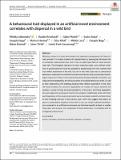Por favor, use este identificador para citar o enlazar a este item:
http://hdl.handle.net/10261/215958COMPARTIR / EXPORTAR:
 SHARE SHARE
 CORE
BASE CORE
BASE
|
|
| Visualizar otros formatos: MARC | Dublin Core | RDF | ORE | MODS | METS | DIDL | DATACITE | |

| Título: | A behavioural trait displayed in an artificial novel environment correlates with dispersal in a wild bird |
Autor: | Jablonszky, Mónika; Krenhardt, Katalin; Markó, Gábor Szász, E.; Hegyi, Gergely; Herényi, Márton; Kötél, D.; Laczi, Miklós; Nagy, Gegerly; Rosivall, Balázs; Török, János; Garamszegi, László Z. CSIC ORCID | Palabras clave: | Activity Consistency Passerine Personality Philopatry Risk-taking |
Fecha de publicación: | 2020 | Editor: | Blackwell Publishing | Citación: | Ethology 126: 540- 552 (2020) | Resumen: | Behaviour shown in a novel environment has important consequences for fitness in many animals. It is widely studied with standard tests by placing the individuals into an unfamiliar experimental area, that is the so-called open-field or novel environment test. The biological relevance of traits measured under such artificial conditions is questionable and could be validated by establishing a link with variables that truly reflect exploration in the wild. Our aim in this field study was to characterize behaviours measured in an artificial novel environment (an aviary) and assess the biological relevance of them in the collared flycatcher (Ficedula albicollis). Therefore, we measured the repeatability and the association of multiple behavioural traits, as well as their relationship with breeding dispersal (that reflects exploration in the wild). We found evidence for non-zero repeatability for number of crosses between the quarters, number of hops and perching latency in the aviary, and these repeatabilities were high when assessed at shorter time windows. Additionally, birds with short perching latency in the novel environment were more likely residents and bred closer to their breeding nest box in the previous year, which may suggest that latency to perch is connected to dispersal in the wild. In sum, our results indicate that behaviours assessed in an artificial environment are individual-specific at least on smaller timescales, and at least, one component of these behaviours is correlated with an ecologically relevant trait. | Versión del editor: | http://dx.doi.org/10.1111/eth.13005 | URI: | http://hdl.handle.net/10261/215958 | DOI: | 10.1111/eth.13005 | Identificadores: | doi: 10.1111/eth.13005 issn: 1439-0310 |
| Aparece en las colecciones: | (EBD) Artículos |
Ficheros en este ítem:
| Fichero | Descripción | Tamaño | Formato | |
|---|---|---|---|---|
| eth.13005.pdf | 547,46 kB | Adobe PDF |  Visualizar/Abrir |
CORE Recommender
SCOPUSTM
Citations
6
checked on 21-abr-2024
WEB OF SCIENCETM
Citations
5
checked on 25-feb-2024
Page view(s)
97
checked on 24-abr-2024
Download(s)
118
checked on 24-abr-2024
Google ScholarTM
Check
Altmetric
Altmetric
NOTA: Los ítems de Digital.CSIC están protegidos por copyright, con todos los derechos reservados, a menos que se indique lo contrario.
